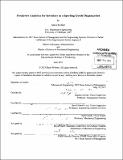| dc.contributor.advisor | Stephen Graves and David Simchi-Levi. | en_US |
| dc.contributor.author | Wolbert, Marie | en_US |
| dc.contributor.other | Leaders for Global Operations Program. | en_US |
| dc.date.accessioned | 2013-09-24T19:37:54Z | |
| dc.date.available | 2013-09-24T19:37:54Z | |
| dc.date.copyright | 2013 | en_US |
| dc.date.issued | 2013 | en_US |
| dc.identifier.uri | http://hdl.handle.net/1721.1/81027 | |
| dc.description | Thesis (M.B.A.)--Massachusetts Institute of Technology, Sloan School of Management; and, (S.M.)--Massachusetts Institute of Technology, Dept. of Mechanical Engineering; in conjunction with the Leaders for Global Operations Program at MIT, 2013. | en_US |
| dc.description | Cataloged from PDF version of thesis. | en_US |
| dc.description | Includes bibliographical references (p. 46). | en_US |
| dc.description.abstract | Inventory management for retail companies has become increasingly more important in recent years as competition grows and new supply chain models are implemented. Inventory levels have implications on not only the financial side of the business, but also on brand perception in the marketplace. Because of the impact of inventory levels on the external perception of Nike's overall financial performance, inventory management continues to be a high priority for the most senior leaders at Nike. The average DSI (Days of Sales in Inventory) has not dramatically changed overall from 2007 to 2012. While the business has made great strides in inventory efficiency (turnover) overall, that efficiency is offset by structural changes in the geography mix, product engine mix, business model mix, channel mix, and manufacturing locations. Nike would like to understand the impact of the structural changes and determine future levels of inventory. The objective of this project is to determine future levels of inventory based on business growth variables as well as optimal levels based on value creation opportunities. This will enable Nike Supply Chain to effectively prioritize improvement opportunities and project the proper inventory levels to stakeholders. The key research objective includes creating a forward-looking model to better understand the structural elements of inventory and the related drivers to each one of those. This model gives Nike the ability to perform scenario planning analysis and quantify value opportunities to determine target levels of inventory, considering different variables of Nike business such as strategies in retail, merchandising, sourcing / manufacturing and sales. Finally, this enables the company to have a standardized process across business geographies and incorporate them into supply chain management cycles already in place. More specifically, this research has proven that the MTS (made-to-stock) inventory order type is becoming increasingly more important to Nike's business. It is essential for Nike to begin tracking this order type at a higher granularity to truly understand future business levers to pull for each geography and product engine. | en_US |
| dc.description.statementofresponsibility | by Marie Wolbert. | en_US |
| dc.format.extent | 75 p. | en_US |
| dc.language.iso | eng | en_US |
| dc.publisher | Massachusetts Institute of Technology | en_US |
| dc.rights | M.I.T. theses are protected by
copyright. They may be viewed from this source for any purpose, but
reproduction or distribution in any format is prohibited without written
permission. See provided URL for inquiries about permission. | en_US |
| dc.rights.uri | http://dspace.mit.edu/handle/1721.1/7582 | en_US |
| dc.subject | Sloan School of Management. | en_US |
| dc.subject | Mechanical Engineering. | en_US |
| dc.subject | Leaders for Global Operations Program. | en_US |
| dc.title | Predictive analytics for inventory in a sporting goods organization | en_US |
| dc.type | Thesis | en_US |
| dc.description.degree | S.M. | en_US |
| dc.description.degree | M.B.A. | en_US |
| dc.contributor.department | Leaders for Global Operations Program at MIT | en_US |
| dc.contributor.department | Massachusetts Institute of Technology. Department of Mechanical Engineering | |
| dc.contributor.department | Sloan School of Management | |
| dc.identifier.oclc | 857790741 | en_US |
